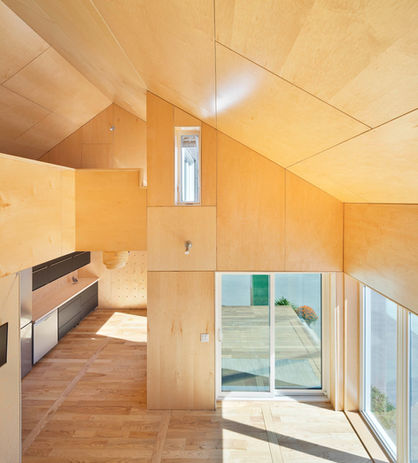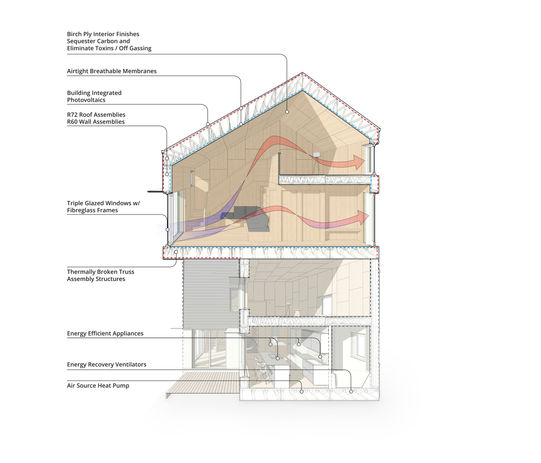zerohouse
Architect:
Cheryl Atkinson Architect
Year:
2019
Location:
Toronto, Ontario

Net-zero energy use, net-zero construction waste, net-zero carbon footprint, and net-zero cost differential to comparable housing were the target goals. Zero House is an innovative housing solution that uses prefabrication and an all-organic palette of structural, insulation and interior cladding materials to address affordability and sustainability. Using black flexible membrane ‘peel and stick’ BIPV (building-integrated photovoltaics), it discretely provides energy for itself and the unit below in a stacked townhouse design. The BIPV from BIPVco in the UK integrates into a prefinished aluminum standing seam roof and exterior wall panels.
The design holistically addresses sustainable housing as an ‘infill’ housing design that can integrate into existing urban neighbourhoods as walk-up apartments over commercial on existing east-west arterial streets. These ‘through unit, two storey stacked townhouses are designed to optimize daylighting and natural ventilation- providing three solar orientations with their indented south-facing terraces. The design can vary to suit various tenants and sites, and the version shown accommodates a second bedroom added to the loft. Passive house construction principles, triple glazed fibreglass framed windows, breathable air barriers allow for an energy-efficient and healthy building envelope.
Students of the Endeavour Centre did the entire construction ( www.endeavour centre.org) off-site in a temporary tent ‘factory’ over three months using only four solar panels to power all power tools and equipment. This 1100 square foot ( 102m2) single unit prototype was exhibited at the EDITdx design and technology expo (www.editdx.com) in Toronto for ten days in October 2017 and was erected in just seven days. The custom prefabricated structural insulated panels were craned into place in a single day and clad over the rest of the week. The building is insulated to withstand Canadian winters using a combination of straw bale and blown-in cellulose insulation for walls and roof and wood fibre exterior insulation. Organic insulation materials store 25 metric tons of carbon versus the 45 metric tons typically added to the atmosphere by conventional construction materials and methods. By removing carbon, greenhouse gas emissions are reduced. At the end of construction, only 18 pounds of non recyclable waste were produced.
The unit interior is clad with FSC certified maple veneer plywood panels by Columbia Forest Products. The solid ash flooring is salvaged from the ash beetle infestation currently damaging Southern Ontario forests. The architectural design was led by Cheryl Atkinson, Architect a Ryerson faculty member with Ryerson University Architectural Science students. The prefabrication research, design and construction were led by Chris Magwood of the Endeavour Centre, a school that teaches sustainable design and construction in Peterborough, Ontario.

The Zero House project exemplifies New Wood Open Architecture through its flexible urban infill strategy and truly sustainable construction and ongoing operation. The 2-storey stacked townhouse unit can be deployed to suit various urban infill sites depending on unique neighbourhood characteristics and density. The system could be used to gently densify an established neighbourhood via laneway or garden suites or applied to a larger site, where multiple units are combined to create a row house typology. Within each two-storey unit, no load-bearing interior walls allow for a high degree of dweller participation in the programming and spatial organization of the dwelling. The loft space is intentionally designed to remain flexible to dwelling needs and can be easily changed throughout the building’s life. The project is committed to sustainability by targeting Net-zero energy use, net-zero construction waste, net-zero carbon footprint, and net-zero cost differential to comparable housing. Wood and other cellulose-based fibres emerged as ideal materials to meet these admirable goals. The prefabricated panels are framed with standard SPF lumber to form a deep wall cavity for which straw and cellulose insulation are inserted to increase the envelope's thermal performance. Rigid Wood fiberboard insulation was then applied as continuous exterior insulation. The Zero House project exemplifies New Wood Open Architecture through its flexible urban infill strategy that is responsive to various housing demands and neighbourhood characteristics. The units also exemplify New Wood Open Architecture by remaining open to individual house needs and commitment to genuinely sustainable construction and ongoing operation.
analysis





































